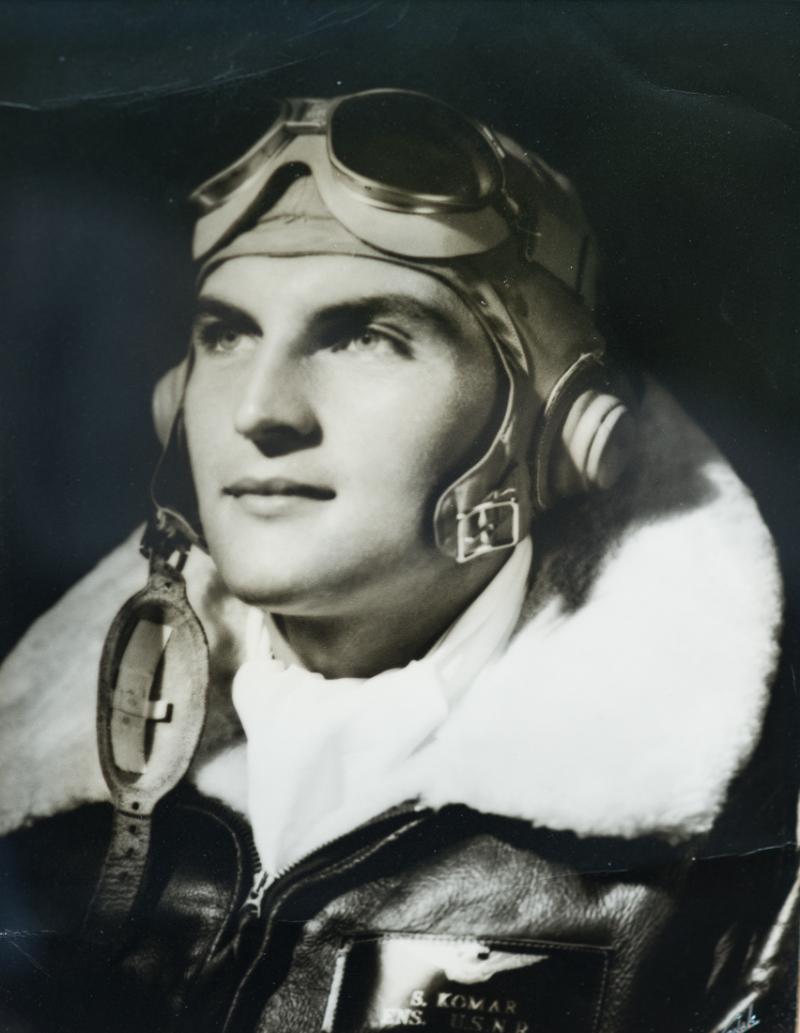
Ens. Stephen Komar, U.S. Naval Reserve
In Memory of My Uncle Steve: Youth, Guts and Gallantry
Sadly, I never met my Uncle Steve. He perished on July 14, 1945, at the young age of 23 during a combat mission against the Kamaishi Iron Works (steel mills) and harbor installations in northern Honshu, Japan, during World War II. Based upon information in letters, photographs and reports collected by my cousin Steve, and from the recollections of my mother, I have learned that my uncle not only was an admired and gallant war hero, but was also a pioneer in naval aviation and a highly skilled pilot. The son of Ukrainian immigrants, my uncle Steve was a handsome, fun-loving all-American young man, loved and respected by his family, friends, peers and superiors. In his honor and memory, I wanted to share his story of service and sacrifice, and immortalize his youth, guts and gallantry. I am preparing a donation to the Naval Aviation Museum and a submission to the Library of Congress Veterans History Project on his service. Additionally, I produced a video dedicated to Ens. Stephen Komar, U.S. Naval Reserve, honoring the sacrifice of all men and women who gave their lives for their country in time of war.The video includes my photographs of several Memorial Day 2013 events in the Washington, D.C., area, and a wreath-laying ceremony at Arlington National Cemetery on the U.S. Army's Birthday and Flag Day in honor of the Army's fallen. The music is credited to the U.S. Army Strings version of "Ashokan Farewell." I wanted to convey the traditions of memorializing and honoring the fallen, but to also encourage all Americans to pay tribute and remember the sacrifice of our servicemembers all year round. http://youtu.be/FSdDbgxXxKI (YouTube video "Gone But Not Forgotten")
I feel a close kindred with my uncle Steve, having enlisted at 23 into the U.S. Army, later to become a commissioned officer with more than 22 years of service before retiring. As a fellow veteran and as his niece, I greatly admire my uncle for his courage and achievements during a brief but remarkable career as a naval aviator. He was born in Woonsocket, R.I., on Oct. 21, 1921, and enlisted in the U.S. Naval Reserve as a aviation cadet on Aug. 18, 1942. He was appointed Ensign, A-V, U.S. Naval Reserve to the rank from April 16, 1944 as a naval aviator. On Jan. 10, 1945, he was assigned to Bombing Fighting Squadron One for duty. He flew the Chance-Vought aircraft, F4U-1D/FG-1D - the Corsair, one of the most advanced aircraft of its era - in the Pacific theater. The Corsair was originally deployed by the U.S. Marine Corps from land bases; however, the U.S. Navy eventually deployed the aircraft off carriers, selecting only the best pilots to fly the missions. Uncle Steve was one of those pioneers. His division of F4U-1D Corsair aircraft deployed from USS Bennington (CV-20) with the mission to neutralize deck guns and anti-aircraft artillery on Japanese destroyer escorts firing on the Bennington observation aircraft. The U.S. Navy SB2C Helldiver observation aircraft provided naval artillery coordinates to U.S. Navy battleships shelling the Kamishi steel mills. In support of the combat action on July 14, 1945, against the steel mills and harbor installations, my uncle flew three mast-head strafing (machine gunning attacks) probably no more than 20-30 feet off the water's surface. For his bravery, Ens. Stephen Komar was awarded the Air Medal posthumously with the following citation:
For meritorious achievement in aerial flight as pilot of a fighter plane, attached to the USS Bennington, in action against the enemy at Kamaishi, Honshu, July 14, 1945. Courageously defying the enemy's shattering antiaircraft fire, as he protected observation planes spotting for naval bombardment of the steel mills. Ensign Komar skillfully pressed home three mast-head strafing attacks on a destroyer escort, and succeeded in destroying the vessel before he lost his life when his plane crashed into the harbor. His expert airmanship and indomitable fighting spirit contributed materially to the success of the first bombardment of the Japanese homeland and were in keeping with the highest traditions of the United States Naval Service. He gallantly gave his life for his country.
In a letter dated July 21, 1945, to his parents, Mr. and Mrs. Samuel Komar, Lt. Robert P. Ross from Bombing Fighting Squadron One described the events on that fateful day. He indicated that my uncle was on his third dive against the Japanese destroyer when his teammates lost sight of him. His division leader circled the area, and a destroyer from their group sped toward the Kamaishi Harbor entrance. The crew on the destroyer witnessed the crash, searched the area, but did not find any survivors. His division blew up and sank the Japanese destroyer. Since his death was confirmed but his remains were not recovered, a headstone was placed for Ensign Komar at Arlington National Cemetery in Memorial Section E. Bombing Fighting Squadron One, formed at Naval Air Station Fallon, Nevada and commissioned on Jan. 2, 1945, became the fourth squadron in the Veteran Air Group One. The squadron lost many exceptional young men during World War II. We owe them our deepest gratitude for their service and sacrifice. Youth, guts and gallantry best describes these incredible individuals.
On this Veterans Day, Nov. 11, 2013, I encourage all Americans to honor and remember the fallen, and to continue to support those who serve in a most honorable and noble profession protecting our freedoms and way of life.
Respectfully,
Karen A. Komar, Lieutenant Colonel, U.S. Army (Retired)
Life Member of the Veterans of Foreign Wars John Lyon Post # 3159
Member of American Legion Post #24
Charter Member of the Women in Military Service for America Memorial Foundation
